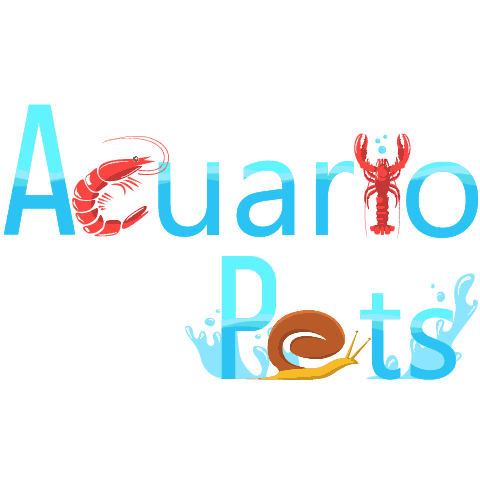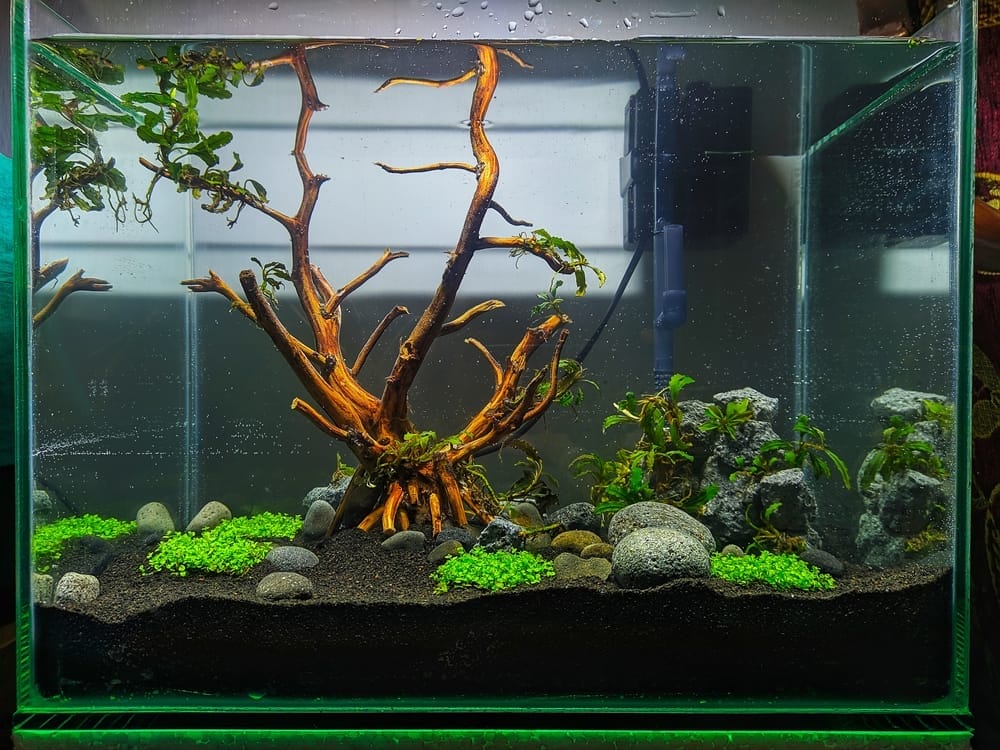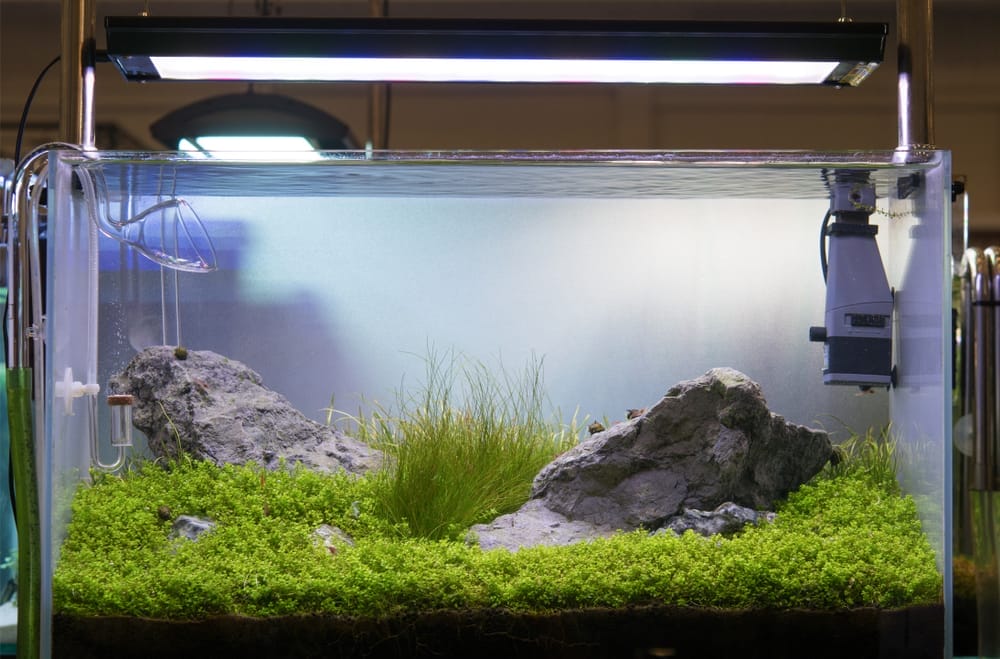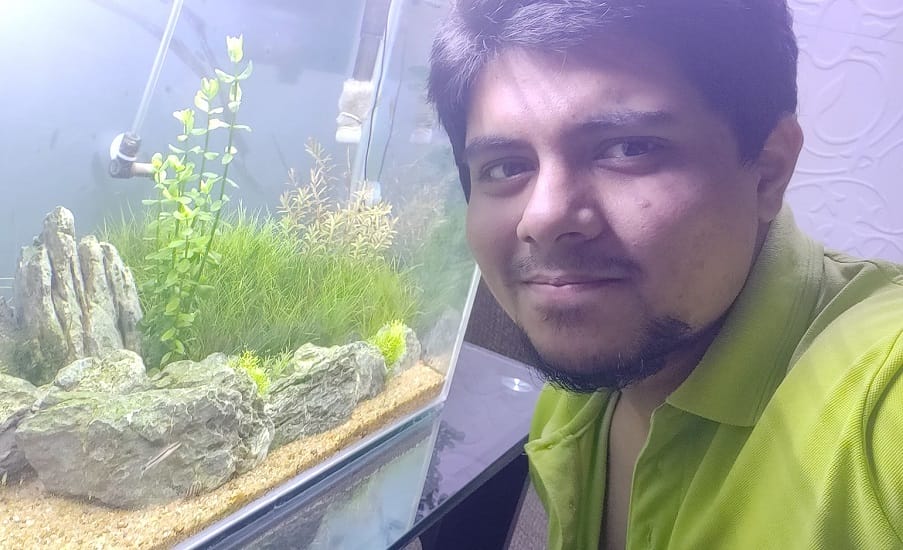This post was created with help from AI tools and carefully reviewed by a human (Muntaseer Rahman) . For more on how we use AI on this site, check out our Editorial Policy.
Check Out These FREE Tools We Made JUST For You!
How to Make Iwagumi Style Bonsai Aquascape?

Are you ready to dive into the serene world of Iwagumi style bonsai aquascaping? Picture this: a tranquil miniature underwater landscape where carefully selected rocks, lush aquatic plants, and the art of bonsai come together to create a harmonious masterpiece.
I was once, just like you, intrigued by the idea of crafting my own iwagumi bonsai mix aquascape, and I’m excited to share my journey and knowledge with you. Let’s embark on this enchanting adventure and learn how to make your very own Iwagumi style bonsai aquascape!
Understanding the Iwagumi Bonsai Mix Style
Creating an Iwagumi Bonsai mix for your aquarium is about blending aesthetics with simplicity. It’s a style that emphasizes harmony and balance, borrowing principles from traditional bonsai art to enhance aquascaping.
Understanding Bonsai Principles in Aquascaping
At the heart of applying bonsai principles to aquascaping is the philosophy of miniaturization and creating a natural landscape within the confines of an aquarium.
I draw inspiration from the beauty found in nature and strive to recreate it on a smaller scale.
This often involves careful selection and placement of rocks and miniature trees to form a simple yet compelling composition.
The Art of Combining Bonsai and Aquascaping
The Iwagumi style, pioneered by Takashi Amano, marries the inherent tranquility of bonsai with the dynamic beauty of aquascaping.
My approach is to select stones as focal points that provide a sense of stability and age. I use a layer of substrate that is conducive to plant growth, ensuring my aquatic plants can thrive and mirror the visual balance I seek.
Through this method, I aim to craft an aquascape that exudes simplicity and harmony, creating an underwater landscape that feels both ancient and timeless.
Choosing the Right Aquarium for Iwagumi Bonsai Aquascape
When I set out to create an Iwagumi Bonsai Aquascape, I found that the first critical step was choosing an appropriate tank. An ideal aquarium serves as the canvas for the aquascape, impacting both the health of the plants and fish and the overall aesthetic.
Selecting the Perfect Tank Size For Iwagumi Bonsai Aquascape
I learned that size really does matter when it comes to selecting a tank for an Iwagumi Bonsai Aquascape.
The scale of the aquascape and the number of rocks and plants I planned to include directly influenced the tank size I needed.
Generally, I preferred larger tanks because they provide more stability in water parameters and more room for design. A standard size for an Iwagumi layout might start at around 60 litres (approximately 16 gallons), but I often considered going larger, up to 120 litres (approximately 32 gallons) or more, to create a striking visual impact.
Essential Equipment for Iwagumi Bonsai Mix Aquascaping
When I begin an Iwagumi bonsai mix aquascape, having the right equipment at hand is critical to achieve the serene and minimalist design characteristic of this style.
Here’s what I need to get started:
- Aquarium: A clear and sizeable tank to provide a canvas for the aquascape layout.
- Substrate: Aquatic plant soil that is nutrient-rich to support plant growth and helps in maintaining the layout.
- Rocks: The defining feature of an Iwagumi aquascape. Select an odd number of stones, with one main stone as the focal point (often called the “Oyaishi”).
- Wood: You’ll obviously need a bonsai style driftwood for making the bonsai.
- Plants: Typically, carpeting plants that can create a lush green landscape. I’ll often choose species like Dwarf Baby Tears or Hairgrass.
- Lighting: LED lights that mimic natural light are essential for plant health and to highlight the aquascape’s features.
- Filter: A high-quality filtration system to keep the water clean and maintain the health of the aquatic environment.
- CO₂ System: For robust plant growth, a CO₂ injection system is often necessary in a densely planted setup.
- Water Additives: To adjust water parameters and provide nutrients to plants.
This equipment forms the foundation of my aquascape, allowing me to carefully arrange the elements that characterize the peaceful simplicity of the Iwagumi style.
how to choose the right bonsai driftwood?
Choosing the right driftwood for your Iwagumi style bonsai aquascape is crucial as it forms the foundation of your miniature tree trunk and adds character to your overall layout.
Here are some key factors to consider when selecting bonsai driftwood:
Size and Scale:
Ensure that the driftwood is appropriately sized for your aquarium. It should be proportionate to the tank’s dimensions and the desired scale of your bonsai tree. A piece that’s too large or too small can disrupt the harmony of your aquascape.
Shape and Form:
Look for driftwood pieces with interesting shapes and forms that resemble the characteristics of a tree trunk. Curved or twisted branches can add a sense of age and maturity to your bonsai tree. Pay attention to the branching pattern and how it can be utilized for attaching mosses and epiphytic plants.
Texture and Surface Features:
Examine the texture and surface features of the driftwood. Natural imperfections, crevices, and knots can enhance the realism of your miniature tree. These features also provide attachment points for mosses and plants.
Wood Type:
Different types of wood have distinct colors and textures. Malaysian driftwood and Mopani wood are commonly used in aquascaping due to their durability and attractive appearance. Consider the wood type in relation to your overall aquascape design.
Buoyancy and Sinking Properties:
Ensure that the driftwood you choose will either naturally sink or can be made to sink without much effort. Some driftwood may require soaking or anchoring initially to prevent it from floating.
Compatibility with Aquatic Life:
Some types of driftwood may release tannins into the water, which can affect water chemistry and color. If you want to avoid this, select driftwood that has been properly cured or aged.
Placement and Integration:
Visualize how the chosen driftwood will fit into your aquascape and how it will interact with other elements like rocks, plants, and substrate. Ensure it can be securely positioned and provide stability for your bonsai tree.
Personal Aesthetic Preference:
Ultimately, your choice of driftwood should align with your personal aesthetic preferences and the overall theme or style of your aquascape. It should contribute to the visual impact and story you want to convey through your bonsai-inspired layout.
Types of Rocks Used in Iwagumi Bonsai Aquascape
In Iwagumi Bonsai Aquascaping, selecting the right stones and positioning them according to nature’s balance is essential. I focus on harmony and simplicity, often using an odd number of rocks to create a natural appearance.
Selecting the Perfect Rocks for Iwagumi
When I choose stones for an Iwagumi aquascape, I look for rocks that resemble Japanese nature.
The oyaishi, or primary stone, is the largest and most impactful. It often represents a mountain and sets the direction of flow in the aquascape.
Complementary stones include the soeishi (secondary stones) and fukuishi (tertiary stones), which support the oyaishi and help portray the natural asymmetry and balance.
The suteishi, or sacrificial stone, is used as an accent and may not be immediately noticeable.
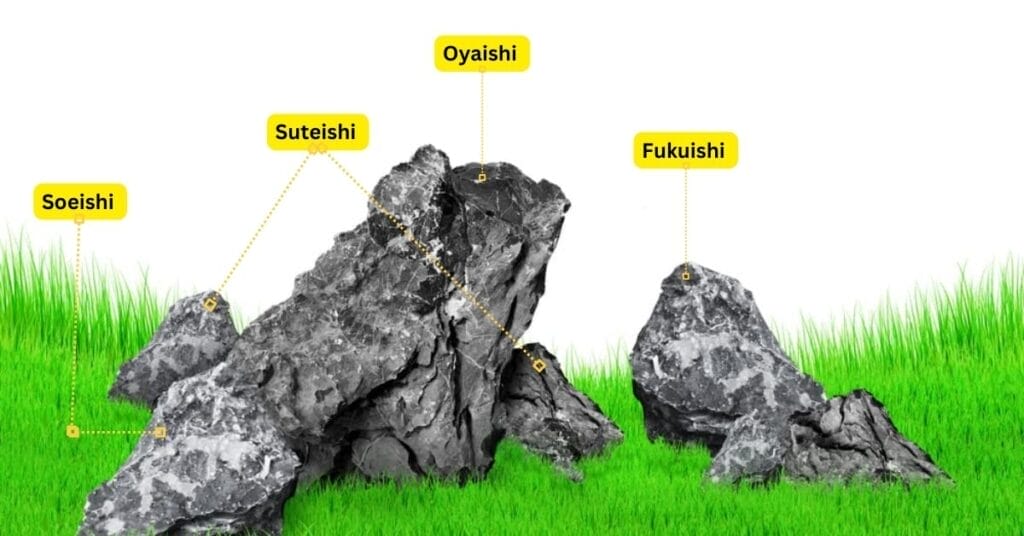
- Oyaishi: Ideally, the oyaishi should be angular with a rugged texture, and it’s often recommended to use a Seiryu stone for its striking, dragon-scale-like appearance.
- Seiryu Stones: A popular choice for their grey color and sharp, craggy texture. They bring a sense of ancient, untouched wilderness to my aquascape.
- Soeishi and Fukuishi: I look for rocks that are smaller but similar in texture and color to the oyaishi to create coherence.
- Suteishi: This stone might not stand out, but it’s important for filling in gaps and completing the natural scene.
When selecting rocks, I ensure I go for an odd number to avoid symmetry, which can appear unnatural. I also think about the golden ratio for harmonious proportions.
How to Arrange Rocks for Aesthetic Appeal
The arrangement of stones in my Iwagumi aquascape aims for simplicity and elegance, often reflecting the gentle and minimalist aspect of nature.
- Proportions: I use the golden ratio as a guide to position the rocks proportionately within the aquarium space. This technique gives my setup a natural and balanced composition.
- Height Variation: By placing the tallest oyaishi off-center and arranging the other stones in descending order of height, I establish depth and perspective.
- Angles and Orientation: I consider the angles at which the rocks tilt. It’s more natural for all stones to lean in one direction, as if shaped by water or wind.
- Spacing: I leave enough space between the stones to avoid a cluttered look and to allow for plant growth. Future maintenance and the health of the plants and fish in the aquarium are also considerations.
By sticking to these principles, I create an aquascape that transports the observer to the serene and structured beauty of a Japanese natural landscape.
Incorporating Bonsai Aesthetics into Aquascapes
When I think about merging the serene beauty of bonsai with aquascaping, key principles come to mind like balance and harmony. My goal is to create an underwater landscape that captures the spirituality and painstaking attention to detail that bonsai represents.
Applying Bonsai Design Concepts to Your Layout
In my approach to an Iwagumi layout, I draw heavily from traditional bonsai design concepts. This means I’m mindful of the rule of thirds, creating an asymmetrical balance that guides the viewer’s eye across the landscape.
Central to this practice is the selection of a dominant, larger stone—often referred to as the ‘Oyaishi’—flanked by smaller complementary stones that don’t compete for attention but rather enhance the composition.
- Principle Elements: Oyaishi (main stone), Fukuishi (secondary stones), Soeishi (auxiliary stones), and Suteishi (sacrificial stones).
- Visual Weight: Larger elements on one side contrasted with smaller, spaced-out elements on the other side.
- Focal Point: Carefully chosen to act as the ‘lead’ in my underwater narrative.
Plant Selection and Placement
My plant selection is crucial in achieving the bonsai-like aesthetics within my aquascape.
I focus on plants that offer fine texture and can be trimmed to mimic the miniature trees of bonsai art.
These are planted with intent, ensuring each has enough room to grow while contributing to the overall balance of the landscape.
- Foreground: Short, carpeting plants such as Eleocharis acicularis (Dwarf Hairgrass).
- Midground: Small, detailed plants like Hemianthus callitrichoides (‘HC’ or Baby Tears).
- Background: Taller, sculptural plants suited for trimming, like Rotala rotundifolia.
Selecting the right plants and placing them thoughtfully is aligned with the pursuit of harmony and balance found in bonsai, creating a tranquil aquascape that feels like a spiritual retreat underwater.
plants to use on the bonsai driftwood
To create a realistic and captivating tree trunk appearance in your Iwagumi style bonsai aquascape, you can use various aquatic mosses and epiphytic plants that can attach to driftwood or hardscape materials.
These plants will simulate the foliage growing on the tree trunk and enhance the natural aesthetic of your miniature bonsai tree.
Here are some suitable plant options:
Christmas Moss (Vesicularia montagnei): Christmas Moss is a popular choice for mimicking the appearance of leaves or foliage on the tree trunk. It forms dense, branching patterns that resemble miniature tree branches.
Weeping Moss (Vesicularia ferriei ‘Weeping’): As the name suggests, Weeping Moss has a cascading growth pattern that can be used to simulate hanging foliage on your tree trunk. It provides a unique and visually appealing texture.
Fissidens Moss (Fissidens fontanus): Fissidens Moss has a lush and feathery appearance that can be used to create a more mature and aged look for your bonsai tree. It’s often chosen for its elegant and soft texture.
Mini Pellia (Riccardia chamedryfolia): Mini Pellia, also known as Riccardia, can be used to resemble miniature fern-like leaves growing on the trunk. It creates a distinctive texture that adds depth to your tree.
Anubias species: Some Anubias species, like Anubias nana and Anubias petite, can be attached to the tree trunk to simulate the appearance of larger leaves or branches. They provide a more substantial and structured look.
When using these plants on the tree trunk, ensure that you securely attach them to the driftwood or hardscape using thread or fishing line until they can naturally adhere. Regular trimming and maintenance will help control their growth and maintain the desired appearance of your bonsai tree.
Experiment with different combinations of these plants to achieve the specific look you want for your Iwagumi style bonsai aquascape, and remember to consider the scale and proportion to maintain a balanced and realistic aesthetic.
Maintaining Iwagumi Bonsai Aquascape
For an Iwagumi Bonsai Aquascape to thrive, it’s crucial that I uphold regular maintenance practices.
Keeping the water crystal clear and the plants healthy requires consistent care and attention to detail.
Routine Maintenance Tasks
| Routine Maintenance Tasks | Details |
|---|---|
| Water changes | Replace 25-30% of the tank’s volume with fresh water once a week to maintain water quality. |
| Fertilization | Dose liquid fertilizers according to the need of aquatic plants to provide nutrients without promoting algae. |
| Daily checks | Inspect plants and Amano shrimp for signs of stress, as they indicate overall health. |
In my experience, the health of an Iwagumi Bonsai Aquascape hinges on systematic maintenance rituals.
At least once a week, I perform water changes, replacing 25-30% of the tank’s volume with fresh water to maintain water quality.
Proper fertilization is also key; I dose liquid fertilizers according to the need of my aquatic plants, ensuring they get all necessary nutrients without promoting excessive algae growth.
Daily, I check for any signs of stress among the plants and the freshwater shrimp, particularly Amano shrimp, as they are great indicators of the aquascape’s overall health.
Preventing Algae and Pest Issues
| Preventing Algae and Pest Issues | Details |
|---|---|
| Lighting management | Limit lighting to 8 hours per day and manage nutrient levels to prevent algae buildup. |
| Amano shrimp | Introduce Amano shrimp to enhance aesthetics and consume algae. |
| Pest removal | Identify and manually remove pests during routine cleaning to mitigate impact. |
To prevent algae buildup, I carefully manage lighting, limiting it to about 8 hours per day, and I keep tabs on nutrient levels.
Additionally, introducing Amano shrimp can serve a dual purpose; they not only enhance the aesthetics but also help keep algae at bay by consuming it.
Pests are unwelcome guests, but early identification and manual removal during routine cleaning can greatly mitigate their impact.
Troubleshooting Common Issues
| Troubleshooting Common Issues | Details |
|---|---|
| Plant nutrient issues | Adjust fertilization if plants show nutrient deficiency or excess like yellowing leaves. |
| Algae outbreaks | Consider adjusting lighting schedule or adding more Amano shrimp if algae appears. |
| Address issues swiftly | Prevent minor problems from disrupting the aquasc |
When I notice my aquatic plants are showing abnormal signs such as yellowing leaves, it’s often an indication of nutrient deficiency or excess.
Adjusting my fertilization schedule usually brings them back to good health. If algae does make an appearance despite my best efforts, I consider adjusting my lighting schedule, or perhaps even adding more Amano shrimp to the cleanup crew.
My goal is always to address issues swiftly to prevent them from unsettling the delicate balance of my aquascape.
About Author
Hello, I’m Muntaseer Rahman, the owner of AcuarioPets.com. I’m passionate about aquarium pets like shrimps, snails, crabs, and crayfish. I’ve created this website to share my expertise and help you provide better care for these amazing pets.
Disclaimer
This site is owned and operated by Muntaseer Rahman. AcuarioPets.com is a participant in the Amazon Services LLC Associates Program, an affiliate advertising program designed to provide a means for sites to earn advertising fees by advertising and linking to Amazon.com. This site also participates in other affiliate programs and is compensated for referring traffic and business to these companies.
